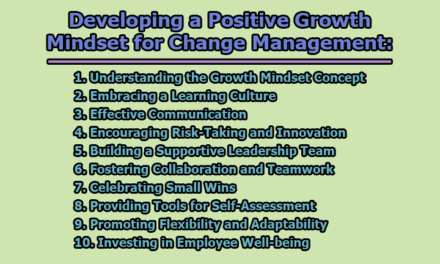Benefits of Positive Organizational Change Management:
Positive Organizational Change Management plays a crucial role in enhancing an organization’s ability to thrive in today’s dynamic and competitive business environment. As emphasized by Dhiman & Marques (2020) and Atkinson et al. (2015), there are several benefits associated with implementing positive change management practices. Some of the essential benefits of positive organizational change management are briefly given below:
1. Adaptation to Evolving Markets and Technological Advances: The ability to adapt to evolving markets and technological advances is vital for organizational success. Positive change management facilitates this adaptability by creating a culture that encourages continuous learning and innovation. By embracing change, organizations position themselves to proactively respond to market shifts and leverage emerging technologies, ensuring they remain competitive and at the forefront of their industry.
2. Resilience in the Face of Challenges: Unforeseen challenges are inevitable in the business world, ranging from economic downturns to global crises. Positive change management contributes to organizational resilience by fostering a mindset that views challenges as opportunities for growth. Through effective communication, transparent leadership, and a well-structured change management process, organizations can build the resilience needed to navigate uncertainties, minimize disruptions, and emerge stronger from adversities.
3. Employee Buy-In, Engagement, and Morale: Employee buy-in is a cornerstone of successful change initiatives. Positive change management ensures that employees are not only informed about the reasons behind the change but are also actively engaged in the process. By involving employees in decision-making, addressing concerns, and recognizing their contributions, organizations cultivate a sense of ownership and commitment. This, in turn, leads to higher morale, increased job satisfaction, and a more motivated workforce.
4. Staff and Leadership Development Opportunities: Change is an opportunity for growth, both for individuals and the organization as a whole. Positive change management provides a platform for staff and leadership development by encouraging continuous learning and skill acquisition. As employees adapt to new processes and technologies, they acquire valuable experiences that contribute to their professional growth. Leadership, too, can evolve through the challenges and responsibilities presented by change, enhancing their strategic capabilities.
5. Fostering a Change-Friendly Culture: A change-friendly culture is essential for organizations aiming to thrive in dynamic environments. Positive change management actively promotes a culture where employees are open to new ideas, receptive to feedback, and adaptable to change. This cultural shift is established through effective communication, leadership support, and a commitment to creating an environment where learning and improvement are celebrated. In such a culture, employees are more likely to embrace change as a natural part of the organizational journey, rather than resisting it.
6. Efficiency Improvements through Process Reevaluation: Positive change management involves a thorough examination and reevaluation of existing processes within an organization. This process allows for the identification of inefficiencies, redundancies, and bottlenecks that may be hindering optimal performance. By streamlining and optimizing processes, organizations can realize efficiency improvements, leading to cost savings, quicker decision-making, and enhanced overall productivity. This commitment to continuous improvement becomes ingrained in the organizational culture, fostering an environment that values efficiency and effectiveness.
7. Team Unification Toward Common Goals: A key aspect of positive change management is the alignment of teams toward common goals and objectives. Through clear communication of the vision behind the change and the role each team plays, positive change initiatives unite employees across various departments. This unity fosters collaboration, enhances teamwork, and breaks down silos, resulting in a more cohesive and synchronized organization. Teams working in harmony are better equipped to tackle challenges, share insights, and collectively contribute to the overall success of the organization.
8. Identification and Management of Risks: Positive change management emphasizes a proactive approach to identifying and managing risks. By anticipating potential challenges associated with the change, organizations can develop strategies to mitigate these risks effectively. This risk-aware mindset ensures that the organization is better prepared to handle unexpected obstacles, reducing the likelihood of major disruptions. Through careful planning and risk management, positive change initiatives are more likely to proceed smoothly, maintaining stability and minimizing negative impacts.
9. Empowering Employees through Autonomy and Ownership: Positive change provides opportunities for employees to take on more significant roles, exercise autonomy, and take ownership of their work. Empowered employees feel a sense of responsibility and accountability, leading to increased job satisfaction and motivation. This empowerment not only enhances individual performance but also contributes to a more innovative and adaptable organizational culture. Employees who feel trusted and valued are more likely to contribute ideas, take calculated risks, and actively participate in the organization’s growth and success.
10 Ensuring Relevance and Financial Viability: Positive organizational change management is inherently linked to the long-term relevance and financial viability of an organization. By staying attuned to market trends, customer needs, and emerging opportunities, organizations can strategically position themselves for sustained success. Proactive change initiatives enable organizations to adapt to evolving circumstances, making informed decisions that ensure continued relevance in the marketplace. Financial viability is enhanced as organizations respond swiftly to changing economic conditions, capitalize on emerging trends, and maintain a competitive edge in their industry.
In conclusion, the benefits of positive organizational change management are far-reaching, touching on various aspects of an organization’s structure, culture, and performance. From fostering resilience to unifying teams and empowering employees, these advantages contribute significantly to an organization’s ability to thrive in today’s dynamic business landscape.
References:
- Atkinson, J., Loftus, E., & Jarvis, J. (2015). The art of change making. Leadership Centre. Retrieved January 16, 2024, from https://www.leadershipcentre.org.uk/publication/item/the-art-of-change-making/
- Dhiman, S., & Marques, J. (2020). New horizons in positive leadership and change: A practical guide for workplace transformation. Springer.

Assistant Teacher at Zinzira Pir Mohammad Pilot School and College










